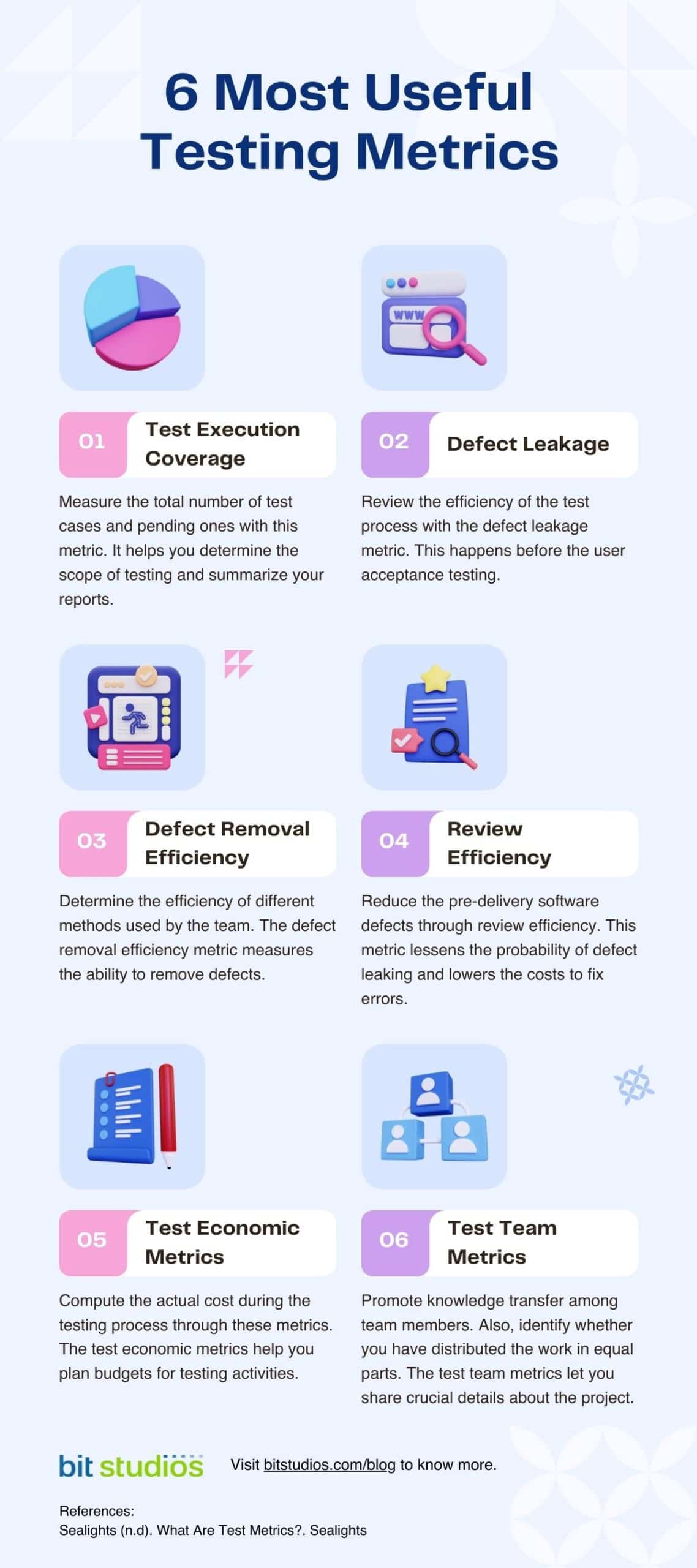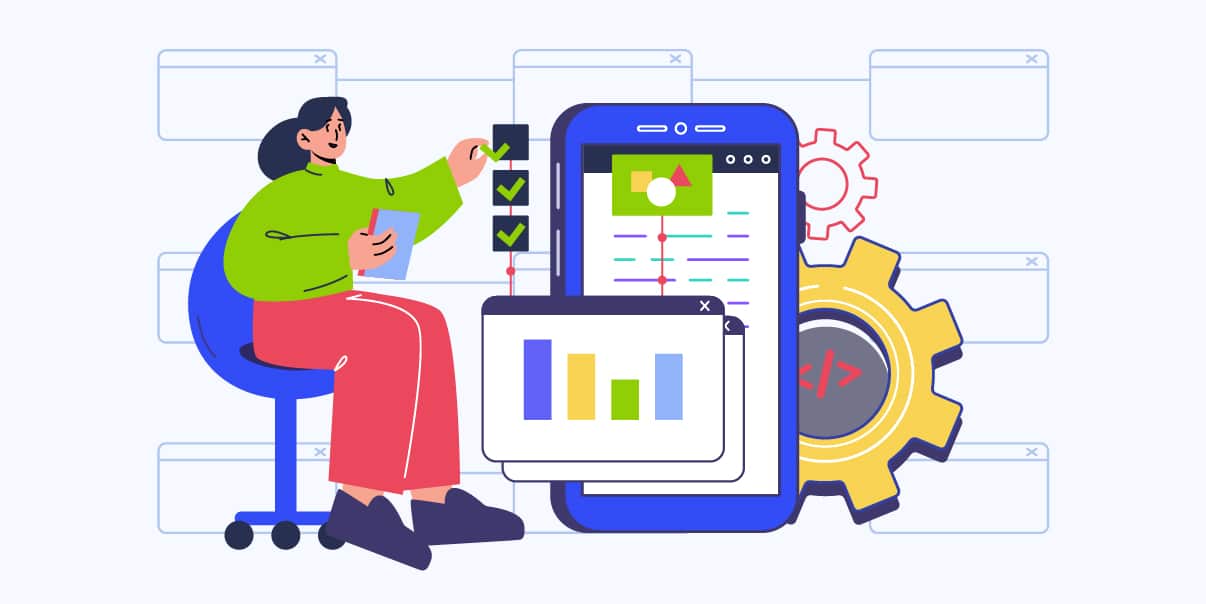A Comprehensive Guide on Software Testing Metrics and Measurement

It is crucial to measure the effectiveness, cost, and quality of software projects. A project will not be successful without these factors.
Testers, agile teams, and QA managers need software testing metrics. These help you get reliable data and enhance efficiency. So, to improve your software testing, you need to track progress, choose the right metrics, and draw a baseline.
What Is Software Testing Metrics?
Metrics are the standards of measurement. Hence, the software testing metrics measure the quality of a project. These are quantitative steps that check the performance and progress of software testing.
Furthermore, these metrics keep track of the quality of the software development cycle. These also give you information to control and decrease the number of errors. Developers can then make precise decisions for future procedures with these testing metrics.
Its purpose is to increase the testing effectiveness of the process. Also, it provides accurate data about the process. Indeed, software testing metrics are indicators of the software testing’s total health.
Software Testing Metrics vs. Software Testing Measurement

Software testing metrics and measurements seem to be the same. But there’s a difference between the two.
As mentioned above, software testing metrics measure the quality of the project. A few examples of quality metrics in software testing are as follows:
- Test coverage percentage
- Number of defects that exist within the module
- Quantity of test cases executed per person
While software testing measurement is a quantitative measure of a product or process. Here are some samples:
- Extent
- Capacity
- Dimension
- Amount
- Size
In short, software testing quality metrics are units that describe an attribute. And the software test measurement is the totality.
Types of Software Testing Metrics

There are different types of metrics in software testing. It is important to understand these to measure the quality of the software.
Here are the three categories of software testing metrics:
1. Process Metrics
It is the characteristics and execution of a project. Process metrics help in improving the efficiency of the software development life cycle.
2. Product Metrics
This type deals with the entire quality of a software product. It defines a product’s design, complexity, size, and performance. With these features, developers can improve the quality of the software.
3. Project Metrics
These metrics assess the whole project’s quality. You can use it to measure the project’s resources, costs, flaws, and productivity.
All the more, it is vital to know the right testing metrics, and here are some factors to keep in mind:
- Select your target audience before creating the metrics.
- Determine the purpose of designing the metrics.
- Prepare the metrics based on the project’s requirements.
- Analyze financial gain related to every metric.
- Match the metrics with the project life cycle stage for best results.
8 Fundamental Software Testing Metrics

The road to metric creation needs software testing fundamentals methods and metrics. These are a combination of absolute numbers used to produce derivative metrics.
1. Test Effectiveness
This metric lets you know the efficiency of test cases executed by the testers. It helps in identifying the quality of test cases. You can also get the value of the number of bugs found and the total number of bugs found on the entire software.
Test Effectiveness = (Number of Defects Found / Number of Test Cases Run) x 100
2. Test Productivity
You can use it to calculate the number of test cases and efforts made by the testers during the testing process. It determines design productivity, and you can use it for future testing estimation.
Test Productivity = (Number of Test Cases / Efforts Spent for Test Case Preparation)
3. Test Coverage
Yet another critical software testing metric is test coverage. It defines the scope of the product’s complete functionality. Additionally, it identifies the areas of the application that you need to test. You can use it as a criterion for concluding testing.
Test Coverage = Number of Defects / Number of Predicted Defects or
Requirements Coverage = (Number of Requirements Covered / Total Number of Requirements) x 100
4. Defect Density
It helps determine the total number of defects in software during development. You can calculate the defect density per thousand lines of the code, also known as KLOC. The results allow you to decide if the software needs more testing or is ready for launch.
Defect Density = Defect Count / Size of the Release or Module
5. Defect Category
This metric provides an insight into the quality attributes of the software, including:
- Stability
- Performance
- Functionality
- Usability
- Reliability
Defect Category = Defects in a Specific Category / Total Number of Defects
6. Defect Severity Index
The defect severity index is the degree of impact a defect has on the software. It helps gauge the quality of the test efforts. The testing team analyzes the impact on the software quality and performance.
Defect Severity Index = Sum of (Defect * Severity Level) / Total Number of Defects
7. Test Efficiency and Tracking
One of the vital components of software testing is test efficiency and tracking. It needs a thorough evaluation to ensure that all testing activities are efficient.
Several test metrics can assist in measuring test efficiency and tracking, such as:
- Passed test case coverage = (Number of Passed Tests / Total Number of Tests Performed) x 100
- Failed test case coverage = (Number of Failed Tests / Total Number of Tests Performed) x 100
- Test cases blocked = (Number of Blocked Tests / Total Number of Tests Performed) x 100
- Critical defects percentage = Total Time Taken for Bug Fixes / Number of Bugs
- Fixed defects percentage = (Defect Fixed / Total Number of Defects Reported) x 100
- Defects deferred percentage = (Defects Deferred for Future Releases / Total Defects Reports) x 100
8. Test Effort
It evaluates the estimated and actual percentage of effort made by the testing team. Also, it aids in understanding any variances and calculating similar future projects.
You can analyze test efforts with the following metrics:
- Number of tests run per period = Number of Test Run / Total Time
- Bug find rate = Total Number of Defects / Total Number of Test Hours
- Average time to test a bug fix = Total Time Between Defect Fix and Re-Test / Total Number of Defects
The Most Useful Software Testing Metrics

Here are various metrics used in software testing that are most useful:
1. Test Execution Coverage
Get an idea about the total number of test cases and the pending ones with test execution coverage. This testing metric identifies the scope of testing. You can summarize your reports with the following parameters below:
- Test cases passed
- Test cases failed
- Executed test cases
- Test cases not executed
- Blocked tests
Test Execution Coverage = (Total Actual Test Cases / Total Number of Planned Test Cases) x 100
2. Defect Leakage
Software developers use this metric to review the efficiency of the test process. It occurs before the user acceptance testing (UAT). If there are defects left undetected by the team and found by the user, defect leakage happens.
Defect Leakage = (Total Number of Defects Found in UAT / Total Number of Defects Found Before UAT) x 100
3. Defect Removal Efficiency
Defect removal efficiency (DRE) calculates the team’s ability to remove software defects. It determines the efficiency of various methods used by the development team. More so, you can measure it per test type.
Defect Removal Efficiency = Number of Defects Resolved / Total Number of Defects During Measurement
4. Review Efficiency
Lower the pre-delivery software defects through the review efficiency metric. Doing so can reduce the cost and efforts used to resolve errors. It can lower the probability of defect leaking in various testing stages. Also, you can confirm test case effectiveness through this metric.
Review Efficiency = Total Number of Review Defects / (Sum of Review and Testing Defects) x 100
5. Test Economic Metrics
Calculate the estimated amount with the actual cost during the testing process. You can achieve this by evaluating the following:
- Total allocated cost of testing
- The actual cost of testing
- Variance from the estimated budget
- Variance from the schedule
- Cost per bug fix
- Cost of not testing
Various aspects contribute to the testing cost, including infrastructure, development tools, and resources. Thus, the test team must also compute these test economic metrics.
6. Test Team Metrics
Test team metrics verify if members need more information about the test process. It determines whether you have distributed the work in equal parts or not.
Additionally, this team metric promotes knowledge transfer among team members. It allows them to share crucial details about the project. Here are the following factors to consider when testing team metrics:
- Returned defects distributed to team members
- Open defects distributed to re-testing
- Number of test cases executed by test team member
Software Testing Key Performance Indicators (KPIs)

Key Performance Indicators or KPIs allow testers to get data measured. These are details analyzed by the development team to ensure process compliance. Even so, these KPIs help make vital steps if the performance does not meet the objectives.
Hence, here are a few KPI metrics for the software testing process that you should keep in mind:
Automated Tests
A test manager must know the automated tests while monitoring the KPIs. It allows the test team to check the number of automated tests to help detect critical errors.
Covered Requirements
The team can track the percentage of the covered requirements of at least one test. The test lead monitors this KPI each day to guarantee 100% test and requirements coverage.
Active Defects
This KPI aids in determining the status of a defect. The active defects let you take actionable steps to fix any errors. Also, you can calculate these based on the threshold set by the team.
Passed Tests
Yet another KPI is the percentage of passed tests. You can track these by monitoring the performance of each test configuration. Doing this helps you understand how effective the configurations are in discovering defects.
Authored Tests
Having authored tests help you analyze the test design activity of the engineers. These are best interpreted by the test manager for better results.
Time to Test
This KPI measures a feature’s time to move from one stage to another. It provides help in computing the effectiveness and efficiency of the testers.
Defect Resolution Time
A defect resolution time measures the time it takes to find and fix software bugs. It tracks the resolution time while calculating the tester’s responsibility for the bugs. From monitoring and resolving the bugs to closing out the issue, this KPI is the right tool for you.
Direct Coverage
It helps you perform manual or automated coverage of a component and tests all features. And when a component is not tested, it will be incomplete and remain as it is until tested.
Defects Fixed Per Day
The test lead tracks the efforts and number of defects made by the team to fix them every day. This KPI also lets you see the progress of the software testing process.
Process Adherence and Improvement
Use this KPI to reward your team’s effort once they streamline the software testing process. Keep them motivated to create agile and accurate solutions.
How to Calculate Test Metrics

To help you calculate metrics of software testing, here are some steps to follow:
1. Determine the software testing process you will measure.
2. Use the data as a baseline to define the test metrics.
3. Identify the information, tracking frequency, and person responsible for the metrics.
4. Ensure the effective management, measurement, and interpretation of the defined metrics.
5. Know the areas of improvement in software testing metrics and measurement.
Sample Formula for Test Metrics
Learn how to calculate the metrics in software testing with formulas. These can help you have a better understanding of how you can come up with the correct calculation.
Use the following formula to get the execution status of test cases in percentage:
Percentage of Test Cases Executed = (Number of Test Cases Executed / Number of Test Cases Written) x 100
You can also compute for other parameters, like blocked, passed, and failed test cases.
Example of Software Test Metrics Calculation

Here are software testing metrics examples to help you calculate test metrics:
- Number of requirements – 10
- Average number of test cases written – 50
- Total number of test cases written – 280
- Total number of test cases executed – 210
- Number of test cases passed – 150
- Number of test cases failed – 55
- Number of test cases blocked – 5
- Number of test cases unexecuted – 70
- Total number of defects identified – 30
- Defects accepted as valid by the team – 20
- Defects deferred for future releases – 10
- Defects fixed – 15
Below are the actual computations:
1. Percentage test cases executed = (Test Cases Executed / Test Cases Written) x 100
= (210 / 280) x 100
= 75
2. Test case effectiveness = (Defects Identified / Number of Test Cases Executed) x 100
= (30 / 210) x 100
= 14.29
3. Failed test cases Percentage = (Number of Failed Test Cases / Number of Test Cases Executed) x 100
= (55 / 210) x 100
= 26.19
4. Blocked test cases percentage = (Number of Test Cases Blocked / Test Cases Executed) x 100
= (5 / 210) x 100
= 2.38
5. Fixed defects percentage = (Number of Defects Fixed / Number of Defects Identified) x 100
= (15 / 30) x 100
= 50
6. Accepted defects percentage = (Defects Accepted as Valid / Number of Defects Identified) x 100
= (20 / 30) x 100
= 66.67
7. Defects deferred percentage = (Defects Deferred for Future Releases / Defects Identified) x 100
= (10 / 30) x 100
= 33.33
The Importance of Test Metrics

Test metrics in software testing are vital for improving product quality. These help each test team to check the efficiency of the process and control them. Also, these provide a range of improvements for the current test process.
These calculated metrics in software testing can further do the following:
1. Help you understand the type of improvement required
2. Make a decision on the modification of the process and for the next activity phase
3. Provide evidence of the predictions
Test Metrics Life Cycle

Here are the four stages of the test metrics life cycle that you should always bear in mind:
Analysis
During this initial stage, developers need to determine the required metrics. You must also define these metrics used in software testing.
Communicate
Explain the importance of the test metrics to stakeholders and the testing team. Furthermore, educate the team on the data points collected to process the metrics.
Evaluation
At this stage, you have to quantify and verify data. Here, the testers need to use the data to measure the metric’s value.
Report
When the evaluation is complete, you can make a detailed conclusion about the process. Then distribute the report among the stakeholders and representatives, and gather their feedback.
Test Metrics Used for Manual and Automated Testing

Various metrics are available to test both manual and automated software testing. Hence, here are the test metrics used for key software testing processes:
Manual Testing
A human tester performs a manual testing process. It is the testing of software in which QA analysts find bugs on their own.
Several manual test metrics are as follows:
- Test case execution
- Test case preparation or test case development
- Defect metrics
Automated Testing
Testers write code or test scripts to automate test execution. This testing uses automation tools to execute test cases and develop test scripts. The goal here is to finish the execution faster.
Here are some automation metrics software testing needed to perform this process:
- Total test duration
- Unit test coverage
- Path coverage
- Requirements coverage
- Percentage of tests passed or failed
- Number of defects found in testing
- Test execution
- Defects in production
- Percentage of automated test coverage of total coverage
Conclusion
Choosing the right testing metrics is the key to successful software testing. A complete dashboard makes a difference to the actual performance and learning process.
At BIT Studios, we offer you complete and reliable software testing and QA services. From manual to automated testing, we have our skilled team to support all your project needs.
Software Testing Metrics and Measurement FAQs
What Are the Most Used Software Testing Metrics?
Pre-determined metrics help organizations assess the quality of their software testing. Thus, below are the most popular or used software testing metrics by developers:
- Test case efficiency
- Test coverage
- Defect cause
- Defect metrics
- Defects finding rate
- Defect severity
- Defect fixing time
- Schedule adherence
How Do You Prepare Test Metrics?
There are various ways to prepare test metrics, such as the following:
- Gather all the tools needed before testing.
- Test as early as possible during software development.
- Perform several performance tests for consistency, and determine metric averages.
- Define the effective calculation, interpretation, and management of the metrics.
- Determine the areas of improvement.
What Are the Benefits of Leveraging Software Testing Metrics?
Software testing metrics have been an integral part of software development. These are useful for analyzing the quality, health, and progress of a testing effort.
So, here are the top benefits of leveraging software testing metrics:
- Achieve cost savings by preventing errors
- Enhance the whole project planning
- Understand if you can get the desired quality
- Enforce keenness to improve the testing process
- Analyze risks well
- Improve defect removal efficiency
- Increase test automation ROI over time
- Better relationship between testing coverage, complexities, and risks of the system
Without metrics, it will be almost impossible to explain or quantify software quality. All the more, metrics provide insight into the status of the testing efforts. This results in better control through smart decision thinking.
Businesses can improve their process by analyzing all the factors mentioned above. They can check their project’s effectiveness and testing efficiency with these metrics.
Know more about software testing metrics and QA services to improve your business. Call BIT Studios today for more information!
We’re BIT Studios!
At BIT Studios we specialize in designing, building, shipping, and scaling beautiful, usable products with blazing-fast efficiency


